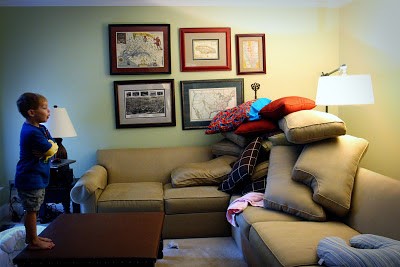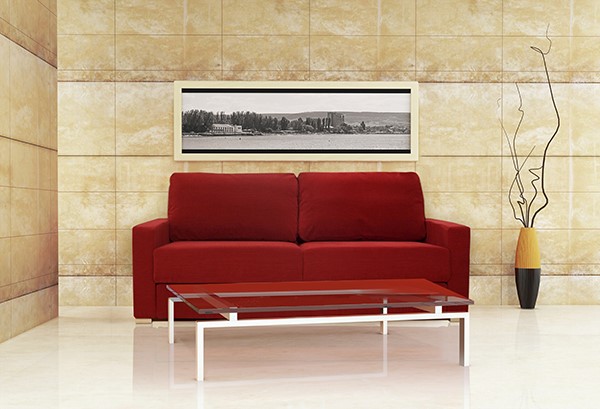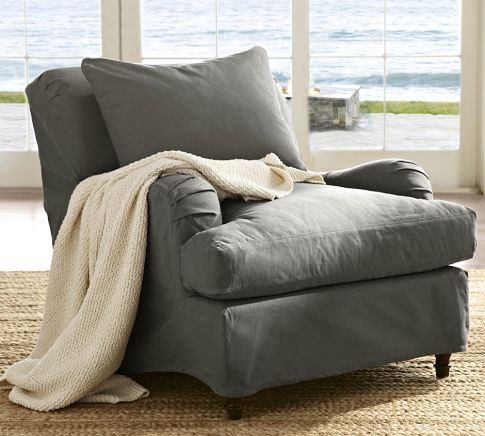
Source: This Perfect Mess
The living room sofa is at the centre of every family’s life. It’s somewhere to sit together, nap together, play together, watch TV, build a fort; a spotless, untarnished sofa is not compatible with family life.
But that doesn’t mean you have to accept a new sofa turning to a mess of finger paint, food stains and deflated cushions within weeks. There are ways to make a sofa more family friendly.
From buying the right settee to preventing stains and cleaning up spills, here is the ultimate guide to children and sofas.
Choosing a new sofa
Fabric vs. Leather
Of course you have your own aesthetic preference, but that may have to play second fiddle when buying a sofa with kids around.
Leather is easier to clean. You can simply wipe it down and the stain is gone. But it it’s also more susceptible to scratches. Clothing and toys can easily do damage to leather upholstery, and there’s not a lot you can do about that. Pets, especially cats still sporting their claws, are bound to leave a mark.
The disadvantage is that if you don’t get to the stain straight away, it can take a lot of work to get it off (if it comes off at all). White leather is particularly susceptible to staining from every day occurrences like denim and oily skin. As great as a new leather sofa looks, a lot of owners complain about being turned into obsessive sofa cleaners to keep them that way. And genuine leather is expensive.
Vinyl is a cheaper alternative that comes in a variety of colours, but tends to be less comfortable and will crack with age.
Generally speaking, fabric sofas aren’t easy to clean. Domestic upholstery cleaners tend to be limited in their effectiveness, and even professional cleaning won’t necessarily get nasty stains out.
However, just like clothes, dark colours and patterns can do a wonderful job of hiding the inevitable spills and scuffs. And they can be as easy to clean as leather, given the right preventative measures (see below).

Image source:Nabru
Whatever you do, if you go fabric, make sure you have removable covers so they can be taken to a professional, or worst case, replaced.
A popular middle path is microfibre – usually synthetic leather or suede. Most people can’t tell the difference and synthetics are a lot cheaper than the real thing. More importantly, thanks to its tight-weave and high thread count, microfibre is stain resistant, making most spillages a simple wipe-off job if you get to them quick enough. They tend to be susceptible to water, so you do have to be careful. And stains will soak in eventually; though a specialist cleaner may be able to get it out.
Other considerations
Get a sturdy sofa. Something solid, built like a tank. No matter how good your children are, they’re sure to put extra strain on it. Even if they don’t jump on it, they’ll certainly do more than just sit on it.
Avoid skirts. They’re magnets for dirt, muddy footprints and crumbs. Bare legs will save a lot of trouble and heartache – particularly by making it easier to retrieve the small, precious objects that inevitably get kicked under the sofa.
Cushion filling comes down to personal preference. However, feather is definitely high maintenance – it really requires daily plumping to keep its shape and appearance. Fibre isn’t as soft, but requires a little less maintenance, though not by much.
Foam tends to feel firmer, which isn’t necessarily a bad thing – after all, a firmer cushion promotes better posture – but is the lowest maintenance of the three, behaving much like a mattress. Foam cushions still need turning, flipping and plumping, but will retain their shape better and longer than the alternatives.
Protective measures

Source: Interiors for Families
No material is completely protected against children. Even easy-to-clean leathers and microfibres are at risk from sticky fingers in one way or another. But there are protective measures you can take to give your sofa a fighting chance.
Slip covers are a popular way of making sofas child-friendly. Although possibly not as chic as what’s underneath, many are easy to clean if you get to the spill straight away, but more importantly – most are machine washable. And you can always take the cover off when guests come round (and the kids are asleep). Worst case, slip covers tend to be inexpensive; replacing an irretrievably stained cover is far cheaper than re-upholstering a sofa.
In a similar vein, simple, traditional throws and rugs achieve the same goal (get the stain on something cheaper than the sofa!) and given the right rug, can give a stylish twist rather than lower the tone. They might even make the sofa more comfortable.
They may seem too good to be true, but furniture protection sprays are actually very effective. They form an invisible barrier making even fabric sofas wipe-cleanable in most cases. Something is bound to get through eventually, but a good dose of spray will certainly prolong the life of your upholstery.
Upholding sofa rules
It may seem obvious, but the obvious bears repeating. If you want to prevent your sofa from child-related destruction, you need to set some ground rules. They won’t always be obeyed, particularly with precocious guests around, but it’s important to set boundaries. If you haven’t had rules before, buying a new sofa is an excellent opportunity to make things clear from the start.
How strict you are depends on how attached to your sofa you are – some people take the view that a home is to be lived in, upholstery be damned. But it’s common to disallow eating and drinking (except for water) on the sofa. Some families go as far as banning food from the living room altogether, which has the upside of promoting family eating at the dining table.
Sofas are for sitting. Not for jumping, wrestling, painting, cutting… A cushion fort is probably OK. This rule will probably be broken more than any other, but you can try.
And the basic ones: no sitting on the edge of cushions, and no sitting on the arms. Adults are prone to violating these as much as children (more?) but they will prolong the life of the sofa.
No matter how sturdy, arms are vulnerable points of the sofa, and sitting on the edge of cushions will make them lose their shape quicker by concentrating too much weight in one place.
Regular maintenance
Simple, regular maintenance will prolong the life of a sofa. The extra strain of children just means the poor couch needs more TLC than one in an adult-only household.
Keeping cushions plump
No matter which filling you plump [sic] for, your cushions will need regular attention if they’re to keep their shape and firmness. Ideally you should:
Plump your cushions daily
Make no mistake, plumping is a very physical activity. For maximum effectiveness, take the cushions of the sofa (seat and back), and give them a good punching on all sides against the hard floor.
Rotate and/or flip cushions monthly
Just as with a mattress, flipping and rotating will even out the wear, so you don’t end up with a huge slump in the middle on one side.
Change seating positions as often as possible
For the same reason as above, change seating position often – if you’re starting to leave a dent in the cushion, it’s not supporting you anymore.
As we’ve already mentioned, foam tends to hold its shape better, so may not need a daily plumping, but a good weekly knocking around is still a good idea.
Maintaining the upholstery
Upholstery will naturally wear and fade over time, losing its texture, but given the right care, its life can be extended.
Brush a fabric sofa weekly
A good brush will stimulate the fibres, easing pressure marks and shading.
Dust leather weekly
If you have a leather sofa, use a clean duster rather than a brush. Don’t use any polish, and be gentle.
Hoover monthly
And make sure you get in the gaps. Use a brush attachment and keep it on as low a setting as you can. This won’t just clear out crumbs, it will also help maintain the upholstery in the same way brushing does.
And finally, flipping the cushions won’t just help maintain plumpness, they’ll reduce, or at least even out, fading from sunlight.
When all else fails
No matter how careful you are, how forceful on the rules, and how many protective measures you’ve taken, sometimes a stain will get through.
There’s a specific solution to nearly every type of stain, and every type of sofa, but the general approach is this:
Get to the stain as quickly as possible
Blot with a damp cloth to dilute the stain – do not scrub
Use an upholstery cleaner as directed on the bottle
Different upholstery cleaners work for different sofas. The furniture tags will tell you what’s appropriate for yours. If you don’t have the tags anymore, try the cleaner on an inconspicuous area of the sofa first.
Acceptance
Ultimately, if you want a pristine sofa, don’t let children near it. At some point you’ll just have to accept that fingerprints, stains and scuffs are inevitable. They might even make it better. Homelier. Lived in.





